Dr. Terror's House of Horrors | Amicus Anthologies
Richard Petro / 12 October, 2025
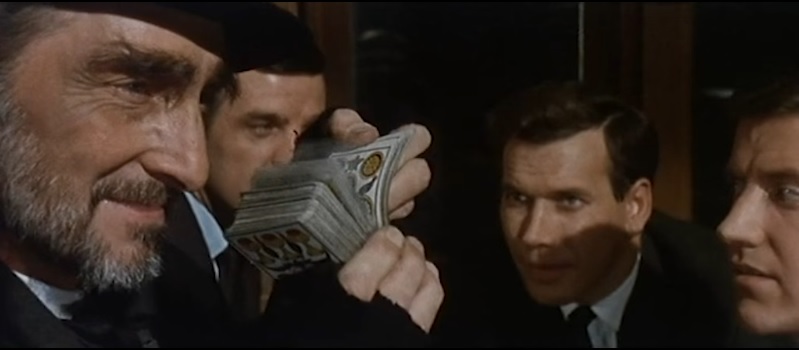
- Directed by: Freddie Francis
- Written by: Milton Subotsky
- Release Date: February 23, 1965
- 98 Minutes
From 1965 to 1974, British film company Amicus Productions released 7 portmanteau (or anthology) films.
I love the Amicus Portmanteau films. I actually just love older anthology horror in general, since I feel like they’re the perfect example of why Halloween is so fun, hanging out with a group, experiencing frights and laughs, creeps and giggles. And while I love many anthologies, it’s the Amicus ones I find myself revisiting. They have the perfect level of charm and an odd sense of warmth. They are very high on the list of some of the best ways to spend an October eve.
So, this week we are going to be going through all of them to see which stories are great, not so great, or a surprise.
Coming out in the terrifying month of February in 1965, Dr Terror’s House of Horrors is the first of Amicus portmanteaus. So, did they hit the ground running? I would give that a resounding kind of-ish. If that would be the proper descriptor.
Though it may not hit some of the feverish, beginning-to-end highs as some of the following fan-favourite instalments, Dr Terror’s still dips perfectly into what it is that people love about films like them. There’s a lot of fun to be had here with some of the segments, with the only real negative being that some of them end up being quite forgettable, especially when you’re looking back on the film after finishing the whole seven film run.
The set-up/in-betweens:
Five men riding the train to the same town are joined by a sixth (Peter Cushing) who claims he can reveal stories about the men with his tarot cards.
While it’s part of the wrap-around, I won’t talk about the endings for these until, well, the end. It’s always neat to see how anthologies end up wheeling out their stories. Here, we have a pretty good and intriguing premise that probably works better at introducing separate characters personalities than some of the later ones, possibly because it feels like we get more time with them to individually interact. Of course, it helps that you once again get Peter Cushing (acting the hell out of his tarot cards) and Christopher Lee (acting the hell out of being a slimy jackass) together, not just on screen, but in a small space. In hindsight, Dr. Terror gives the characters more of a chance to bicker amongst themselves and feels a bit more fun outside of just the stories because of it.
Werewolf:
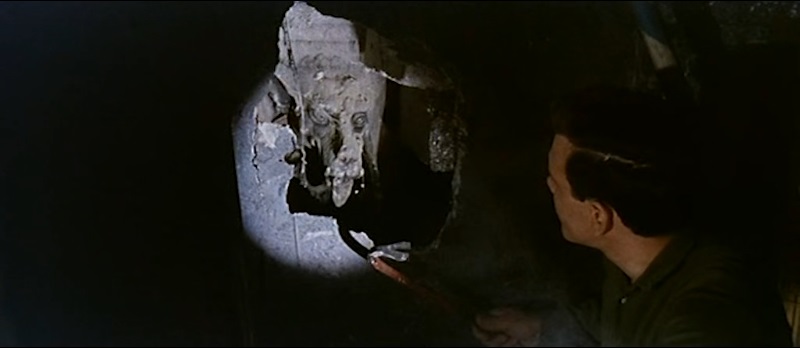
Renovating his old family home, Jim Dawson uncovers a secret that may not be dead.
So, the very first portmanteau movie from a slew of portmanteau movies I love hits us with a story that I absolutely, one hundred percent could not remember for the life of me. I mean, at all. I remembered the rest of the segments in the film (and the others) but for whatever reason this one had flown so far over my head it may as well have been nonexistent.
Re-watching it, that made sense. There is a bit to enjoy here, such as the atmosphere, the mystery, the early hints of Edgar Allan Poe-ness of it all (lot of plaster walls hiding secrets here), but at the end of the day it ends up hitting this wall where it seems like someone suddenly shot up and said “oh yeah, there are other segments.” Werewolf hits its conclusion feeling incomplete, a story that probably yearned for a lengthier runtime than simply being one of five short stories in a film, especially since I think having a bit more time to saunter would have made the ending have more of an oomph to it, some time to fully sink in, instead of dumping it and moving on.
Creeping Vine
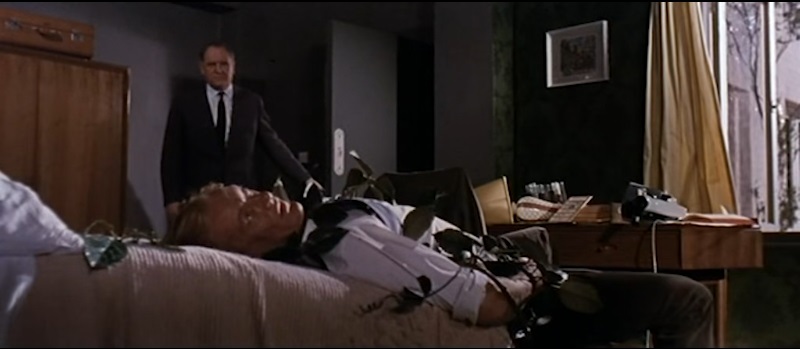
Bill Rogers and his family find themselves, and their home, overcome by a fast-growing vine in their garden.
Creeping Vine fairs slightly better than the first story in that I remembered it, so that’s a good start, but what I really enjoyed about the placement of the stories here is that it seems like there was some decent level of thought in how to split them up.
Werewolf is a quiet build that moves very gingerly whereas Creeping Vine just absolutely hits the ground running, laying out what it’s about and escalating the situation more and more. There’s also a lot to just enjoy here; I’m always a big fan of old films with attacking plants, since it can be charming to see branches jerkily whip around, and they do have people simply up and believe (and conduct experiments!) the fact that someone told them their vegetation is attacking them. The ending of the story, though, is a double-edged sword. It’s clever in what it presents and obviously hints towards what’s to come off-screen in its Plant Life Ruling future, but it still winds up feeling like it simply…stops. It doesn’t hurt anything though, as the story is still charmingly fun and the kind of seasonal wackiness you can enjoy.
Voodoo
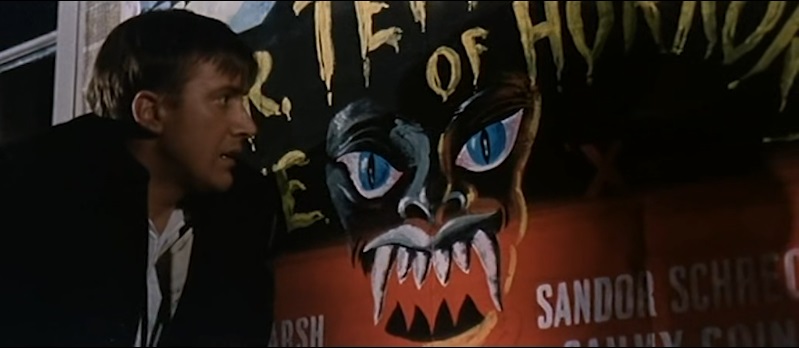
A jazz musician visiting the West Indies comes across a voodoo ritual where he hears music he decides to incorporate into his own work, despite warnings not to.
Boy oh boy, white people, right?
You can always kind of expect voodoo to show up in some way, shape, or form in some corner of older horror, and it’s nice to see that, here, it’s pretty much tied into a first-world dingleberry’s disrespect for another culture, especially under the pretense of “hey, this music is great… I can make a lot of money off it!”
That being said, I think people’s enjoyment of this story will probably be the one that swings one way or another the most, as it takes a more comedic approach, if it can be described as that. See, Roy Castle’s Biff Bailey character talks. A lot. And whether you find him annoying or not may also hinder your feelings towards it. My issues with the story actually didn’t have anything to do with Castle’s performance, actually I think his performance is important, since he’s supposed to be someone who is so daft and full of it that you want to see him get his well earned comeuppance… the problem is that the story concludes in a way that doesn’t really tie things up satisfyingly, instead coming to a stop. I know I said the same thing for Creeping Vine, but that story at least had the benefit that the threat towards the characters would continue in some way. Here the threat has to do specifically with the character at hand and, because of that, the way it ends feels like a lot of fun build up for something that ends up feeling empty afterwards.
Disembodied Hand
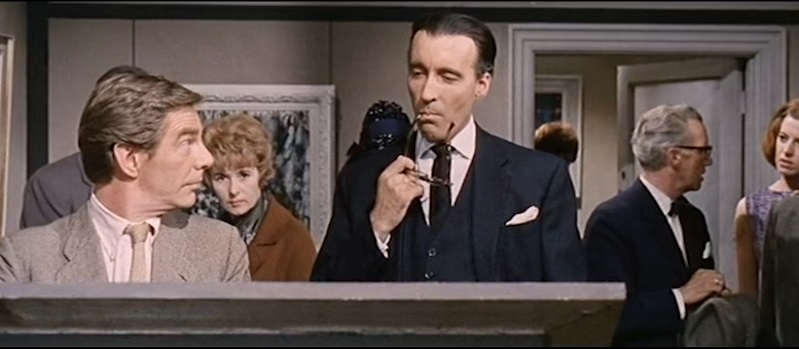
Painter Eric Landor finds himself at odds with Franklyn Marsh, an art critic who enjoys putting others down more than the art itself.
Now this, this is the good stuff. Whereas there is enough to say makes certain individual stories lean one way or another, have positives or negatives, Disembodied Hand feels like an early example of a quintessential Anthology Film Segment. The story? Perfect Halloween fun. The acting? Fantastic. The wrap up twist? Hilarious, with it possibly being predictable not at all taking away from it. It is just x amount of minutes of greatness. Christopher Lee is his usual fantastic self here and has a wonderful foil in Michael Gough. Hell, if I had a negative about this segment it’s that I wish it was a full-length feature just so I can have more Lee and Gough going back and forth.
While it’s easy and predictable to heap praise on Christopher Lee, I think my biggest take away from the story is that I desperately wish Michael Gough had returned to another Amicus portmanteau film in some way, shape, or form. I can easily stamp this as a must-see based purely on the fun of its two actors along with the direction that makes Lee being attacked by a hand never fall into pure ludicrous territory, and that doesn’t even include the fact that Lee and Gough have a pretty good argument about Art vs Criticism in the beginning either. Great, great stuff.
Vampire
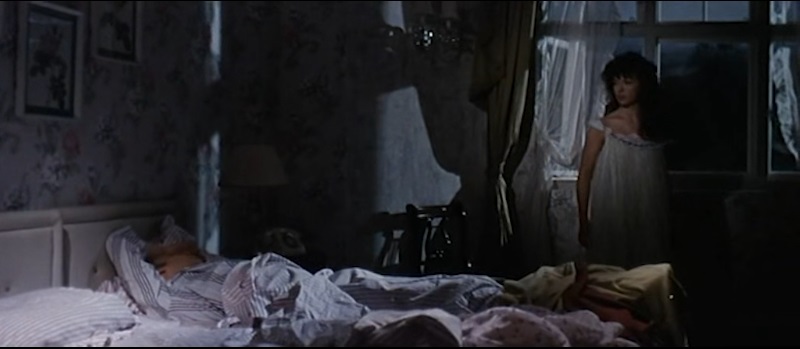
A vampire is on the loose, which may not bode well for Dr. Bob Carroll and his new French bride.
Vampire is quite the story to finish on as I’m never actually sure what to say about it. It’s a story that’s a lot of fun and, like Creeping Vine, doesn’t skirt along on mystery but hits the ground running, laying forth what it’s about and what’s coming (the reveal of the vampire is not a shock at all).
But all of this equals a story that is relatively serious in the way it unfolds and then ends in such a ridiculous but, in my mind, macabrely and genuinely hilarious kicker that I can’t help but have fondness for it. It’s a story that wraps things up with a sweet smile, if you find the end hitting you the same way it did me.
The Wrap-Around Twist
I will say, being born 24 years after the film came out and a few years more before I got around to it, I’m curious how an ending like this hit the first time it was seen. This should come as no surprise to anyone who has seen a single anthology with this type of framing, but all the characters are revealed to have died in a train accident. It’s no surprise to us but I’d love to know how people reacted back in the day. The big fun here is the reveal of Cushing’s character when he rejoins the rest of them and what form he takes. It’s fantastic.
All around, Dr Terror’s House of Horrors ends up being a relatively good anthology that makes it obvious why Amicus kept going with them. I actually think that Dr Terror may be a bit underrated at the end of the day, since most fans end up hovering around some of the other future instalments and this one may be remembered more as being “the first one.” Still, if someone told me they decided to not watch it I would absolutely argue whole-heartedly for Disembodied Hand. Seriously, at least try to find a way to see it just for that segment, it’s delightfully delicious.
